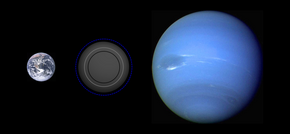 Size comparison of Gliese 581g with Earth and Neptune (Based on selected hypothetical modeled compositions) | |
| Discovery | |
|---|---|
| Discovered by | Steven S. Vogt et al.[1] |
| Discovery site | Keck Observatory, Hawaii[2][3][4] |
| Discovery date | September 29, 2010[1][5] |
| Radial velocity[1] | |
| Orbital characteristics | |
| Epoch JD 2451409.762[1] | |
| 0.13 AU (19,000,000 km)[6] | |
| Eccentricity | 0[1] |
| 32[6] d | |
| 271 ± 48[1] | |
| Semi-amplitude | 1.29 ± 0.19[1] |
| Star | Gliese 581[1][7] |
| Physical characteristics | |
| Temperature | 242 K (−31 °C; −24 °F) to 261 K (−12 °C; 10 °F)[8] |
Gliese 581g /ˈɡliːzə/ was a candidate exoplanet postulated to orbit within the Gliese 581 system, twenty light-years from Earth.[9] It was discovered by the Lick–Carnegie Exoplanet Survey, and was the sixth planet claimed to orbit the star;[10] however, its existence could not be confirmed by the European Southern Observatory (ESO) / High Accuracy Radial Velocity Planet Searcher (HARPS) survey team, and was ultimately refuted.[9][11][12] It was thought to be near the middle of the habitable zone of its star,[13] meaning it could sustain liquid water—a necessity for all known life—on its surface, if there are favorable atmospheric conditions on the planet.
Gliese 581g was claimed to be detected by astronomers of the Lick–Carnegie Exoplanet Survey. The authors stated that data sets from both the High Resolution Echelle Spectrometer (HIRES) and HARPS were needed to sense the planet; however, the ESO/HARPS survey team could not confirm its existence. The planet remained unconfirmed as consensus for its existence could not be reached. Additional reanalysis only found evidence for four planets, but the discoverer, Steven S. Vogt, did not agree with those conclusions. In 2012, a reanalysis by Vogt supported its existence.[14] A new study in 2014 concluded that it was a false positive,[15][9] a conclusion which has been further confirmed by subsequent studies.[12] The planet was thought to be tidally locked to its star. If the planet has a dense atmosphere, it may be able to circulate heat. The actual habitability of the planet depends on the composition of its surface and the atmosphere. It was thought to have temperatures around −37 to −11 °C (−35 to 12 °F). By comparison, Earth has an average surface temperature of 15 °C (59 °F)—while Mars has an average surface temperature of about −63 °C (−81 °F). The planet was said by Vogt to have a "100%" chance of supporting life.[16] The supposed detection of Gliese 581g was said to foreshadow what Vogt called "a second Age of Discovery".[1]
- ^ a b c d e f g h i Cite error: The named reference
Vogt 2010was invoked but never defined (see the help page). - ^ Cite error: The named reference
Smith 2010was invoked but never defined (see the help page). - ^ Cite error: The named reference
Overbye 2012was invoked but never defined (see the help page). - ^ Cite error: The named reference
Alleyne 2010was invoked but never defined (see the help page). - ^ Cite error: The named reference
Sanders 2010was invoked but never defined (see the help page). - ^ a b Cite error: The named reference
Vogt 2012was invoked but never defined (see the help page). - ^ Cite error: The named reference
Quenqua 2014was invoked but never defined (see the help page). - ^ Cite error: The named reference
Stephens 2010was invoked but never defined (see the help page). - ^ a b c Cite error: The named reference
Robertson 2014was invoked but never defined (see the help page). - ^ Cite error: The named reference
Hsu 2010was invoked but never defined (see the help page). - ^ Cite error: The named reference
Trifonov2018was invoked but never defined (see the help page). - ^ a b Cite error: The named reference
Dodson-Robinson2022was invoked but never defined (see the help page). - ^ Cite error: The named reference
Howell 2016was invoked but never defined (see the help page). - ^ Cite error: The named reference
Wall; July 23, 2012was invoked but never defined (see the help page). - ^ Cite error: The named reference
Grant 2014was invoked but never defined (see the help page). - ^ Cite error: The named reference
Press Release 10-172 - Videowas invoked but never defined (see the help page).